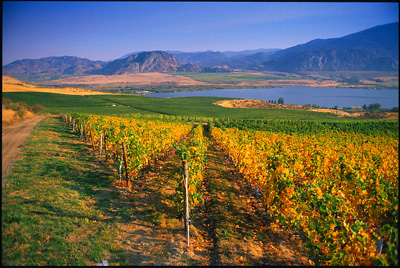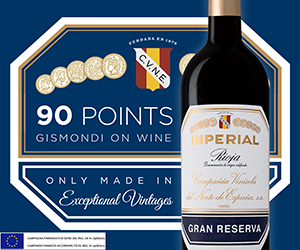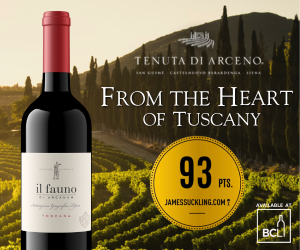Earlier this month Osoyoos Larose drew a new line in the Okanagan sand for wine quality using traditional Bordeaux grape varieties.
Osoyoos Larose, the wine and the project, is a joint venture between Canadian-owned Vincor International Inc. and Bordeaux based Group Taillan. Vincor is North America's fourth-largest wine producer whose brands include Jackson-Triggs and Inniskillin Wines (both Okanagan and Ontario versions), Sumac Ridge Estate Winery and Hawthorne Mountain Vineyards in the Okanagan; R.H. Phillips, Toasted Head and Hogue Cellars in the United States; Goundrey Wines and Amberley Estate in Australia; and Kim Crawford in New Zealand.
Group Taillan is no shrinking violet either, given its claim to being the largest producer of appellation controlee wines in France, with operations in Bordeaux, the Cotes du Rhone, the Loire Valley, Provence and Languedoc. The group also lays claim to six Bordeaux estates: the "grand cru classe" properties of Chateau Gruaud-Larose, St-Julien, Chateau Ferriere, Margaux and Chateau Haut Bages Liberal, Pauillac.
Merlot and, in a much smaller way, pinot noir have been the focus of most of B.C.'s best red wines, at least those made post-1995. Osoyoos Larose takes us in a different direction, using cabernet sauvignon, cabernet franc and merlot in its first release and the winery plans to quickly add a small amount of petit verdot and malbec to succeeding vintages.
The goal of the partners was to work with classic Bordeaux grape varietals to create Canadian wines with global stature. Although it's far too early to comment on the global stature of Osoyoos Larose, I'm impressed with this wine for many reasons.
First, it is a stand-alone wine solo effort -- and not one of a dozen or more different labels that is closer to the norm in the Okanagan. There is no other focus at Osoyoos Larose and it shows in the attention to detail.
Viticulture is the centre of the wine at the moment and almost all of the project's energy is directed at the Osoyoos Larose bench where under the direction of Antoine Merlaut, managing director of Groupe Taillan, no expense has been spared.
Frenchman Alain Sutre is the point man in the vineyards and has been instrumental, along with winemaker Pascal Madevon, in developing the gentle-sloping vineyard blocks that make up the Osoyoos Larose vineyard.
When you stand at the top of the densely planted, meticulously laid-out vineyard, the vines appear to tumble down the hillside and disappear into the lake. From the outset Sutre has worked hard to balance the meagre mix of sand and gravel with the addition of organic material and fertilizers. He has also installed an intricate system of spray nozzles to irrigate the vines without wetting the leaves and thus reducing the incidence of plant disease.
The vines, an unusual (for B.C.) 5,000 per hectare, offer several rootstock and clone combinations. Each is imported from the Mercier nursery in Bordeaux. The trellising system allows for detailed canopy management, such as shading only one side of the vine for sun protection, and the density of vines helps to naturally regulate the bunch yield per vine, keeping them low.
It's not revolutionary viticulture, or even totally French, but seeing everything in one place, on one vineyard, concentrated on making one wine, is enough to make a crusty old wine writer weep.
Everything at Osoyoos Larose is done by hand, from pruning to picking to leaf stripping. The blocks are picked in successive passings taking only the fruit that is physiologically ripe.
The premier edition of Osoyoos Larose has an impressive dark, black cherry colour and a nose that mixes chocolate, green olive and bell pepper scents with smoke, vanilla, pepper and black cherry aromas. The entry is smooth with dry, chalky, grainy tannins that give the red a measure of grip in the mouth. More cedar, smoke, pepper, black olive, cassis and vanilla mark the flavour and give it a Bordelais style.
It's still young and tight and should improve over the next three to five years. The 2001 blend is 66/25/9 merlot/cabernet sauvignon/cabernet franc. Perhaps its best attribute is balance that, even in a so-so vintage like 2001, gives the wine an instant pedigree that is never easy to come by.
At the media release we tasted some spectacular, super-ripe components that will go into the 2003 edition, including some malbec and petit verdot all signalling a bright future.
Given all the work and expense and its initial quality, the $35 price tag for Osoyoos Larose is just about right. Next, the Okanagan red goes on the road to New York, London and Paris to tell its story. Osoyoos may never be the same again.
Look for Osoyoos Larose in a handful of specialty wine shops, VQA wine stores and restaurants across the country in the coming weeks and months.

 quicksearch
quicksearch






